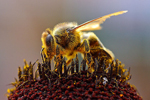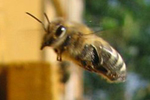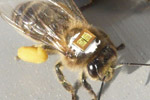Sprinkled with pollen, buzzing bees fly from one blossom to another, collecting sweet nectar from brilliantly colored flowers. Bees tend to symbolize the pollination process, but there are many wild insects that carry out the same function. Unfortunately, wild insect populations are in decline, and, according to a recent study, adding more honey bees may not be a viable solution.
Creatures like beetles, flies, butterflies and wild bees pollinate flowers before they can develop into mature fruits and seeds, or a fruit set. This is an especially valuable process to the agricultural industry as the system ultimately boosts the number of harvested crops.
“All around the world people are looking for ways to make agricultural production more efficient,” said co-author Saul Cunningham, a researcher with the Commonwealth Scientific and Industrial Research Organization in Australia. Cunningham was one of fifty researchers from across the globe that contributed to the study published recently in Science.
“At the same time there is global concern that biodiversity loss is continuing at a dangerous rate,” Cunningham continued.

Squash bee and cucumber beetles in cucumber flower. Photo courtesy of Garibaldi et al.
Forests and grasslands once neighbored agricultural landscapes, providing habitats for wild insect pollinators. The insects would visit nearby crop fields, enhancing the pollination process. Nature manages the pollination process at no cost to humans, branding wild insect pollination as an “ecosystem service.”
But as the number of adjacent habitats has declined, so has the abundance and diversity of the wild insects that once lived there, resulting in fewer crop visits. According to the study, the pollination of crop flowers by wild insects is a vulnerable service.
Honey bees have long been viewed as a substitute for vanishing wild pollinators. Some crops like almond, blueberry or watermelon are routinely stocked with a high number of bees to promote and improve pollination, a tradition that crosses continental boundaries. However, the idea of honey bees replacing abundant and diverse wild insects is not well understood.
“Our study challenges the widespread assumption that crop pollination services provided by wild insects can be replaced by a single domesticated species, the honey bee, without a loss in crop production,” said Rachael Winfree with Rutgers University in New Jersey, a contributing scientist to the study.
The researchers analyzed data from 600 fields, hitting every continent on which food is grown. The group observed 41 crop systems, ranging from annual and perennial fruits, seeds and nuts to stimulant crops like coffee. Some fields contained an assortment of crops while others were monocultures with only one crop.
The insect species and abundance were also diverse. Several crops were stocked with a high number of honey bees; others had a variety of wild insects. The researchers measured flower visitation for each species of insect and calculated pollen deposition.
“The results were impressive,” said Lucas Garibaldi with the Universidad Nacional de Río Negro in Argentina, lead researcher of the study. “We found that wild insects consistently enhanced the number of flowers setting fruits or seeds for a broad range of crops and agricultural practices on all continents with farmland.”
Based on the study’s findings, wild insects pollinated crops more effectively due to more visitations. In fields with a low number of wild insects the fruit set was also much lower.
Managed honey bees supplemented the pollination process, but did not take the place of the wild insects. In fact, relying on a single pollinator like the honey bee could be detrimental to the crops if pathogens, predators or pesticides ravage the insect population, which has been observed during the Colony Collapse Disorder of honey bees in the U.S. and Europe.
If wild insect pollinators continue to decline in agricultural landscapes, crop harvests may be negatively affected. The study suggests that farmers move to more sustainable management practices that include both honey bees and diverse wild insects, such as the conservation or restoration of neighboring natural habitats to promote natural pollinators.
This research shows maintaining biodiversity in agricultural landscapes supports agricultural production, Cunningham said. “More generally it highlights that understanding how biodiversity underpins ecosystem services to agriculture is vital to our future.”

Bee hives in California almond orchard. Photo courtesy of Garibaldi et al.

Wild bee visiting almond flower. Photo courtesy of Garibaldi et al.
CITATION: Garibaldi et al. (2013) Wild pollinators enhance fruit set of crops regardless of honey bee abundance. Science: March 2013, Vol. 339, No. 6127, pp. 1608-1611.
Related articles
Common pesticides disrupt brain functioning in bees
(03/27/2013) Exposure to commonly used pesticides directly disrupts brain functioning in bees, according to new research in Nature. While the study is the first to record that popular pesticides directly injure bee brain physiology, it adds to a slew of recent studies showing that pesticides, especially neonicotinoids, are capable of devastating bee hives and may be, at least, partly responsible for on-going Colony Collapse Disorder (CCD).
EU pushes ban on pesticides linked to bee downfall

(02/05/2013) Following a flood of damning research on the longterm impact of neonicotinoid pesticides on bee colonies, the EU is proposing a two year ban on the popular pesticides for crops that attract bees, such as corn, sunflower, oil seed rape, cotton. The proposal comes shortly after European Food Safety Authority (EFSA) released a report that found neonicotinoid pesticides posed a “number of risks” to bees.
New study adds to evidence that common pesticides decimating bee colonies

(10/24/2012) The evidence that common pesticides may be partly to blame for a decline in bees keeps piling up. Several recent studies have shown that pesticides known as “neonicotinoid” may cause various long-term impacts on bee colonies, including fewer queens, foraging bees losing their way, and in some cases total hive collapse. The studies have been so convincing that recently France banned the use of neonicotinoid pesticides. Now a new study finds further evidence of harm caused by pesticides, including that bees who are exposed to more than one chemical, i.e. neonicotinoid and pyrethroid, were the most vulnerable.
Organic yields lag behind industrial farming, but that’s not the whole story

(04/26/2012) In general, industrial agriculture beats organic farming in yields, according to a comprehensive new study in Nature. The study adds new data to the sometimes heated debate of organic versus conventional farming. Proponents of organic farming argue that these practices are environmentally friendly, sustainable over the long-term, and provide a number of social goods. However, critics argue that organic farming requires more land, thereby increasing global deforestation, which offsets any other environmental benefits of organic food production. At stake is whether organic or conventional is capable of feeding the world’s seven billion people (and rising), including increasing demand for energy-intensive foods like meat in the developing world.
Researchers recreate bee collapse with pesticide-laced corn syrup

(04/05/2012) Scientists with the Harvard School of Public Health (HSPH) have re-created the mysterious Colony Collapse Disorder in several honeybee hives simply by giving them small doses of a popular pesticide, imidacloprid. Bee populations have been dying mysteriously throughout North America and Europe since 2006, but the cause behind the decline, known as Colony Collapse Disorder, has eluded scientists. However, coming on the heels of two studies published last week in Science that linked bee declines to neonicotinoid pesticides, of which imidacloprid is one, the new study adds more evidence that the major player behind Colony Collapse Disorder is not disease, or mites, but pesticides that began to be widely used in the 1990s.
Smoking gun for bee collapse? popular pesticides

(03/29/2012) Commonly used pesticides may be a primary driver of the collapsing bee populations, finds two new studies in Science. The studies, one focused on honeybees and the other on bumblebees, found that even small doses of these pesticides, which target insect’s central nervous system, impact bee behavior and, ultimately, their survival. The studies may have far-reaching repercussions for the regulation of agricultural chemicals, known as neonicotinoid insecticides, that have been in use since the 1990s.
What does Nature give us? A special Earth Day article

(04/22/2011) There is no question that Earth has been a giving planet. Everything humans have needed to survive, and thrive, was provided by the natural world around us: food, water, medicine, materials for shelter, and even natural cycles such as climate and nutrients. Scientists have come to term such gifts ‘ecosystem services’, however the recognition of such services goes back thousands of years, and perhaps even farther if one accepts the caves paintings at Lascaux as evidence. Yet we have so disconnected ourselves from the natural world that it is easy—and often convenient—to forget that nature remains as giving as ever, even as it vanishes bit-by-bit. The rise of technology and industry may have distanced us superficially from nature, but it has not changed our reliance on the natural world: most of what we use and consume on a daily basis remains the product of multitudes of interactions within nature, and many of those interactions are imperiled. Beyond such physical goods, the natural world provides less tangible, but just as important, gifts in terms of beauty, art, and spirituality.
The value of the little guy, an interview with Tyler Prize-winning entomologist May Berenbaum

(04/06/2011) May Berenbaum knows a thing or two about insects: in recognition of her lifelong work on the interactions between insects and plants, she has had a character on The X-Files named after her, received the Public Understanding of Science and Technology Award for her work in making science accessible to the public, and this year has been awarded the prestigious Tyler Environmental Prize. “Winning the Tyler Prize is an incredible honor—most of my scientific heroes have been Tyler Prize winners and I’m exceedingly grateful to be considered worthy of being included among their ranks,” Berenbaum told mongabay.com in an interview. “The Prize is also tremendously enabling—because the money is unrestricted I can use it to carry out projects that have been difficult to fund.”